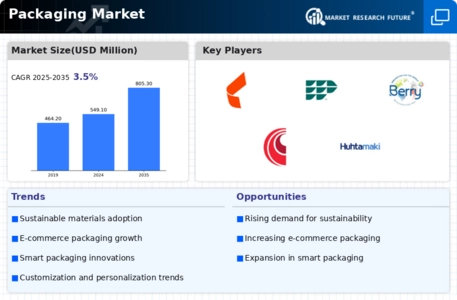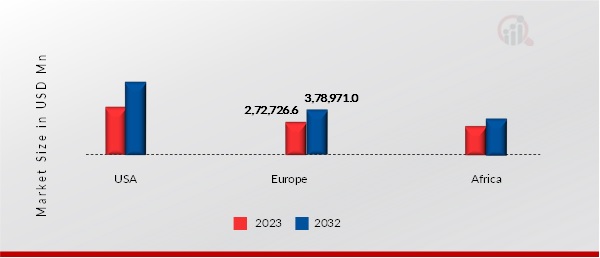Market Analysis
Packaging Market (Global, 2024)
Introduction
A PERIOD OF TRANSITION. The market for packages is undergoing a period of change, resulting from changing tastes, the need for greater concern for the environment, and the introduction of new technical devices. As businesses try to increase the visibility of their products and ensure the safety of their products in transit, the importance of an innovation in the field of packages increases. The growth of e-commerce has increased the need for efficient and protective packages, and companies are forced to review their strategies in order to meet the demands of consumers who are more aware of the environment. Regulations and the reduction of the use of plastics lead manufacturers to sustainable materials and methods, in a competitive environment where adaptation and creativity are essential. This report analyzes the evolution of the market for packages, highlighting the major trends and the most important factors influencing its future.
PESTLE Analysis
- Political
- In 2024, the packaging market is influenced by government regulations aimed at reducing the use of plastics. For example, the European Union has adopted a directive requiring a collection rate of 90% for plastic bottles by 2029, which will affect the 300,000 tons of plastic packaging produced annually in the European Union. Similarly, some countries are introducing taxes on single-use plastics, with the United Kingdom imposing a tax of 200 pounds per ton of plastic packaging that is not at least 30% re-usable from April 2024.
- Economic
- In 2024 the world economy is characterized by fluctuating prices of raw materials, which directly affect the packaging market. For example, in the first quarter of 2024 the price of polyethylene, a commonly used packaging material, rose by about 15 % compared to the previous year, due to the disruption of supply chains and the growing demand. In the United States alone, the packaging industry employs about 1,5 million people, thereby demonstrating its importance for the economy and the labor market.
- Social
- Towards a sustainable packaging system, 72% of consumers are willing to pay more for products with a sustainable package. Among young people, this trend is even more pronounced. Among millennials, 85% prefer to buy brands that care about the environment. The companies in the packaging market are responding to these changing demands by investing more in biodegradable and recyclable materials.
- Technological
- In 2024, the market for packaging is changing, notably through the use of smart packages. By the end of 2024, the market for smart packages (including NFC and QR codes) will reach $ 30 billion. These devices, which engage consumers and provide valuable data to manufacturers, will lead to new innovations in the tracking and tracing of products and the management of inventories. Also, the automation of the packaging process will increase productivity, and over 40 per cent of packaging companies plan to invest in automation technology in 2017.
- Legal
- In 2024 the packaging market finds itself in the midst of a complex legal framework, particularly in terms of the environment. The American EPA has tightened up its regulations on packaging waste management and requires annual reporting on the data on packaging waste. Fines of up to fifty thousand dollars per infringement are a powerful incentive to companies to adopt more sustainable practices. Furthermore, in some states the extended producer responsibility (EPR) legislation is being implemented, which means that producers are being asked to take responsibility for the entire life cycle of their products.
- Environmental
- In 2024 the market for packaging is dominated by the environment. It is estimated that each year about 300 million tons of plastic are produced, a significant part of which ends up in dumps and in the sea. In response, many companies have committed to reducing their carbon footprint, with the goal of reaching zero emissions by 2050. For example, major packaging companies have invested over a billion dollars in research and development of sustainable materials and recycling technology, with the aim of reducing plastic waste and promoting the circular economy.
Porter's Five Forces
- Threat of New Entrants
- The market for packaging in 2024 is subject to a moderate threat of new entrants. There are large, well-established companies in the industry with a strong brand and a significant share of the market. However, the growing demand for sustainable and new packaging solutions opens up opportunities for new companies. The high capital requirements and the high degree of supervision can, however, deter potential new entrants.
- Bargaining Power of Suppliers
- Suppliers in the packaging market generally have low bargaining power, as a result of the wide availability of raw materials and the availability of alternative sources. The many suppliers of materials such as plastics, paper and metals make it easy for manufacturers to change suppliers, thus reducing the bargaining power of suppliers.
- Bargaining Power of Buyers
- In the market for containers, buyers are in a strong position, especially large retailers and manufacturers who buy in bulk. They can demand lower prices and better quality, which puts suppliers under pressure to develop new products and improve their offering. The growing focus on the environment and sustainability also makes it easier for buyers to choose suppliers that are in line with their own environmental goals.
- Threat of Substitutes
- The threat of substitutes in the packaging market is moderate. Although biodegradable and re-usable alternatives to conventional packaging materials are on the rise, the unique properties of certain materials such as glass and metals make them indispensable for certain applications. However, the trend towards greater sustainability is driving innovation in substitutes.
- Competitive Rivalry
- Competition in the market for paperboard is very strong, with many companies vying for market share. To differentiate their products, companies are constantly launching new products, which has led to intense price competition and marketing. In addition, the rapid evolution in the preferences of consumers, especially for more sustainable packaging, has led to a further increase in competition among companies.
SWOT Analysis
Strengths
- Diverse range of materials and technologies available for packaging solutions.
- Growing demand for sustainable and eco-friendly packaging options.
- Strong innovation in smart packaging technologies enhancing product safety and shelf life.
Weaknesses
- High costs associated with advanced packaging materials and technologies.
- Regulatory challenges related to packaging waste and recycling.
- Dependence on fluctuating raw material prices impacting profit margins.
Opportunities
- Expansion of e-commerce driving demand for innovative packaging solutions.
- Increasing consumer preference for sustainable packaging creating new market segments.
- Technological advancements in automation and digital printing enhancing production efficiency.
Threats
- Intense competition leading to price wars and reduced profitability.
- Economic downturns affecting consumer spending and demand for packaged goods.
- Stringent regulations on packaging waste and environmental impact posing compliance challenges.
Summary
The packaging market in 2024 will be characterized by a strong focus on innovation and sustainable development, which reflects the preferences of consumers. It will, however, be weakened by the high costs and regulatory challenges. Opportunities lie in the growing e-commerce and the shift towards eco-friendly solutions. Competition and the economy will pose a threat to market stability. In this dynamic environment, companies must use their strengths and opportunities and minimize their weaknesses and threats.








Leave a Comment